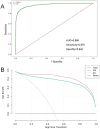Development and comparison of machine learning-based models for predicting heart failure after acute myocardial infarction
- PMID: 37620904
- PMCID: PMC10463624
- DOI: 10.1186/s12911-023-02240-1
Development and comparison of machine learning-based models for predicting heart failure after acute myocardial infarction
Abstract
Aims: Heart failure (HF) is one of the common adverse cardiovascular events after acute myocardial infarction (AMI), but the predictive efficacy of numerous machine learning (ML) built models is unclear. This study aimed to build an optimal model to predict the occurrence of HF in AMI patients by comparing seven ML algorithms.
Methods: Cohort 1 included AMI patients from 2018 to 2019 divided into HF and control groups. All first routine test data of the study subjects were collected as the features to be selected for the model, and seven ML algorithms with screenable features were evaluated. Cohort 2 contains AMI patients from 2020 to 2021 to establish an early warning model with external validation. ROC curve and DCA curve to analyze the diagnostic efficacy and clinical benefit of the model respectively.
Results: The best performer among the seven ML algorithms was XgBoost, and the features of XgBoost algorithm for troponin I, triglycerides, urine red blood cell count, γ-glutamyl transpeptidase, glucose, urine specific gravity, prothrombin time, prealbumin, and urea were ranked high in importance. The AUC of the HF-Lab9 prediction model built by the XgBoost algorithm was 0.966 and had good clinical benefits.
Conclusions: This study screened the optimal ML algorithm as XgBoost and developed the model HF-Lab9 will improve the accuracy of clinicians in assessing the occurrence of HF after AMI and provide a reference for the selection of subsequent model-building algorithms.
Keywords: Acute myocardial infarction; Extreme gradient boosting; Heart failure; Machine learning; Model.
© 2023. BioMed Central Ltd., part of Springer Nature.
Conflict of interest statement
The authors declare that the research was conducted in the absence of any commercial or financial relationships that could be construed as a potential conflict of interest.
Figures
References
-
- Hung J, Teng TH, Finn J, Knuiman M, Briffa T, Stewart S, Sanfilippo FM, Ridout S, Hobbs M. Trends from 1996 to 2007 in incidence and mortality outcomes of heart failure after acute myocardial infarction: a population-based study of 20,812 patients with first acute myocardial infarction in western Australia. J Am Heart Assoc. 2013;2(5):e000172. doi: 10.1161/JAHA.113.000172. - DOI - PMC - PubMed
-
- Sulo G, Igland J, Vollset SE, Nygard O, Ebbing M, Sulo E, Egeland GM, Tell GS. Heart failure complicating Acute myocardial infarction; burden and timing of occurrence: a Nation-wide analysis including 86 771 patients from the Cardiovascular Disease in Norway (CVDNOR) Project. J Am Heart Assoc 2016, 5(1). - PMC - PubMed
MeSH terms
LinkOut - more resources
Full Text Sources
Medical
Research Materials
Miscellaneous



